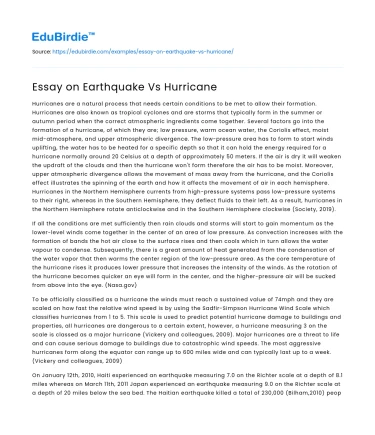Introduction
Natural disasters pose significant threats to human life and infrastructure. Among them, earthquakes and hurricanes represent some of the most devastating events, each characterized by unique features and impacts. Earthquakes, caused by the sudden release of energy in the Earth's crust, can lead to massive destruction without warning. Hurricanes, on the other hand, are powerful tropical cyclones that develop over warm ocean waters, offering some degree of predictability before landfall. Both phenomena have a profound influence on the environment and human societies, yet they differ in their origins, manifestations, and the strategies required for risk mitigation. This essay will explore the critical differences and similarities between earthquakes and hurricanes, examining their causes, effects, and the measures taken to protect against them. By understanding these distinctions, policymakers and researchers can better prepare for and respond to these natural calamities, ultimately reducing their devastating impacts.
Geophysical and Atmospheric Origins
Earthquakes and hurricanes originate from distinct geophysical and atmospheric processes. Earthquakes occur due to tectonic plate movements, which result in the accumulation of stress along fault lines. When this stress exceeds the strength of rocks, it releases energy in the form of seismic waves, causing the ground to shake. According to the United States Geological Survey (USGS), approximately 500,000 detectable earthquakes occur globally each year, with around 100,000 strong enough to be felt, and about 100 causing significant damage. An example of a catastrophic earthquake is the 2010 Haiti earthquake, which resulted in over 200,000 fatalities and left millions homeless.
Save your time!
We can take care of your essay
- Proper editing and formatting
- Free revision, title page, and bibliography
- Flexible prices and money-back guarantee
Conversely, hurricanes are large-scale atmospheric phenomena driven by the heat from warm ocean surfaces. The Coriolis effect, a product of Earth's rotation, causes these storms to spin, intensifying their power as they gather moisture and energy. Hurricanes are classified into categories based on their wind speeds, with Category 5 being the most severe. The 2005 Hurricane Katrina exemplifies the destructive potential of hurricanes, resulting in widespread devastation across the Gulf Coast of the United States and causing over 1,800 deaths. Unlike earthquakes, hurricanes can be tracked and predicted days before they make landfall, allowing for evacuation and other preparatory measures.
Despite their differences, both earthquakes and hurricanes are natural phenomena with complex interactions within Earth's systems. Advances in technology and science have improved our understanding of these processes, yet challenges remain in predicting earthquakes accurately and mitigating the impacts of hurricanes.
Impact on Human Societies and Infrastructure
The impacts of earthquakes and hurricanes on human societies and infrastructure are profound and multifaceted. Earthquakes can cause instantaneous destruction, leading to collapsed buildings, ruptured roads, and damaged utilities. In urban areas, the density of infrastructure exacerbates the potential for catastrophic damage and loss of life. The 1994 Northridge earthquake in California, for instance, led to significant economic losses, estimated at $44 billion, highlighting the vulnerability of urban environments to seismic events.
Hurricanes, while slower in manifestation, can cause extensive damage through high winds, storm surges, and flooding. The aftermath of Hurricane Sandy in 2012 demonstrated the far-reaching effects of such storms, with extensive flooding in New York City and damages exceeding $70 billion. Coastal regions are particularly vulnerable to hurricanes, necessitating robust infrastructure and community preparedness plans to minimize damage.
Both earthquakes and hurricanes necessitate comprehensive disaster management strategies, including building codes, land-use planning, and community education programs. However, the nature of these strategies differs: earthquake-prone regions focus on structural resilience and emergency response, while hurricane-prone areas emphasize evacuation planning and coastal defenses. Despite these efforts, socioeconomic disparities often influence the effectiveness of disaster response and recovery, as seen in the varied impacts of Hurricane Katrina across different demographic groups.
Mitigation and Preparedness Strategies
Effective mitigation and preparedness strategies are crucial in reducing the impacts of earthquakes and hurricanes. For earthquakes, engineering innovations play a vital role in enhancing the resilience of structures. Building designs that incorporate base isolators and energy dissipating devices can significantly reduce damage during seismic events. Japan, a country prone to earthquakes, has implemented stringent building codes that have proven effective in minimizing casualties and damage.
Hurricane preparedness, by contrast, involves a combination of structural and non-structural measures. Coastal defenses such as seawalls and levees can protect against storm surges, while improved forecasting technologies allow for timely evacuations. Community awareness programs and emergency drills are essential components of hurricane preparedness, enabling residents to respond effectively when a storm approaches.
Moreover, international cooperation and data sharing enhance global capabilities in disaster preparedness. The Global Earthquake Model (GEM) and the National Hurricane Center (NHC) are examples of collaborative efforts to improve risk assessment and early warning systems. However, challenges remain in ensuring equitable access to these resources, particularly in developing regions where vulnerabilities are often highest.
Conclusion
In conclusion, earthquakes and hurricanes, though distinct in their origins and manifestations, share the commonality of posing significant risks to human societies and infrastructure. Understanding their differences and similarities is essential for developing effective strategies to mitigate their impacts. While significant progress has been made in predicting and preparing for these natural disasters, continuous advancements in science, technology, and policy are necessary to enhance resilience and reduce vulnerabilities. By fostering a culture of preparedness and investing in robust infrastructure, communities can better withstand the challenges posed by earthquakes and hurricanes, ultimately safeguarding lives and livelihoods.
As climate change continues to influence weather patterns and tectonic activity, the frequency and intensity of natural disasters may increase, further underscoring the need for comprehensive and adaptive disaster management strategies. Through global collaboration and sustained research efforts, humanity can strive to coexist with the dynamic forces of nature, minimizing the adverse effects of these powerful phenomena.






 Stuck on your essay?
Stuck on your essay?

